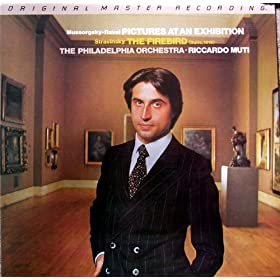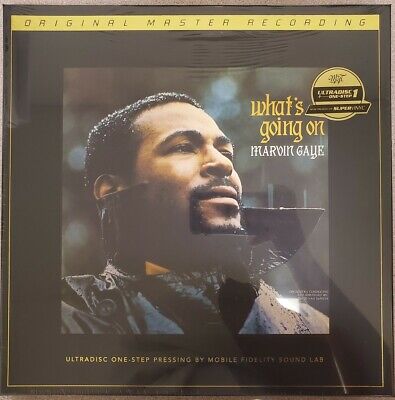Mofi, Mofi, Mofi. Is there anything left to say? Perhaps.
First off: I really have no skin in this game. The few older Mobile Fidelity LP’s that I’ve picked up over the years have been enjoyable, including Rickie Lee Jones, Sundown, and the Firebird Suite/Pictures At An Exhibition conducted by Muti. This hails back to when you could find those titles for $10-20. Once the prices of Mofi LP’s started soaring (I mean the first time, 25+ years ago) I largely lost interest in them, and haven’t bought or even heard any of the recent crop of work they’ve done over the last decade. So I’m somewhat ignorant, but also objective. It’s not that I thought a Marvin Gaye “One-step” (at $125 US or whatever) wasn’t worthwhile. It just wasn’t something I was interested in, for various reasons, price being one. My overall interest in vinyl also isn’t what it used to be. And I’ve had good results with other reissue companies, and I’ve stuck with them. More on that in a moment.

For me personally there are two issues that dictate a record purchase: desirability and sound quality (I suppose price is a factor too, haha). If you think the same way, then which of these you prioritize higher may determine your reaction to the Mofi “crisis”. “Desirable” can be (and is) defined in so many ways. If your favourite artist, let’s say Jack White, releases a new album, it’s desirable for you to have it on vinyl, for obvious reasons. If Mofi releases a limited edition one-step, say 5,000 copies, that LP can become desirable because it will sell out and become a rarity, driving the price up. In that sense, you could say we now have (at least) three types of LP buyer: the record collector, the speculator, and the audiophile. Then you have the music lover, who could also be any of the above. And the poser – say a college kid who has some records on the shelf just because it’s cool. Beyond that of course, there are musicians, DJ’s, etc. But let’s stick to the first three for this discussion.
My take
I’ll try to keep it simple. For me there’s a magic line here, and we can just call it “1980”. From roughly that year on, digital recording has been the norm, 99.9% of the time. Prior to 1980, virtually 100% of recorded music was recorded to analog tape (or occasionally direct to disc).
Now, pre-1980 recordings – and especially jazz, blues and classical LP’s from the 50’s and 60’s – are of great interest to many of us. This was the analog “golden age”, aka the hi-fi revolution, when great development leaps were seen in recording techniques; and technically, in microphones, tape decks, and in mixing – including the advent of stereo. Record cutting and pressing also came of age during this time. And the music was legendary. That’s why original pressings of many 50’s/60’s recordings are so coveted.
Bottom Line

I don’t know many people who consider Mofi to be the pinnacle of vinyl reissues. But they’ve had some excellent releases, and are clearly an important player. Mofi also has one of (if not the) broadest catalogs, spanning just about every genre of modern music, representing many of the top record labels. In Mofi’s earlier history they put many good reissues into our hands, for premium but ‘reasonable’ prices. In more recent years their prime releases have been, by most measures, quite expensive. Their “One-step” releases have sold well – the hype around these has been the target for much of this summer’s banter over the mastering process. I’ll concede that, IT IS POSSIBLE that some of these are the “best-sounding” vinyl versions available. For me, if it’s a golden-age recording and I want it bad enough to pay premium reissue prices – then I want it to be an analog copy, for better or worse. Just as I want the jacket and label to look and feel as authentic to the original as possible, I also want the record to sound like a facsimile of its original version. Is this a rational take? I don’t know. I’m old enough to remember “disco sucks” and “perfect sound forever”. We all have our biases. I AM OPEN to the possibility that a DSD-mastered vinyl reissue could be sonically ‘superior’ in some ways to an all-analog version. But as a record buyer, I identify more as a collector than an audiophile, so I want my copy of something from 1959 to be analogous to the way it was produced at that time. Mofi LP’s will drop in value, and that’s a deserved correction. It doesn’t make them worthless – if you enjoy listening to them, keep on spinning! I would like to see Mofi get through this – they have to come clean and walk back misrepresentations, e.g. terms like “ultra-analog”. I’d also like to see less trolling and grandstanding and outright misinformation online, but it’s unlikely that wish will be granted. The paragraph is too long. Sorry.


If it’s DSD, I want the SACD and not the vinyl. I like the different companies that go with the all analog approach. MoFi is also known for their quality digital products. I think if they were honest and released fewer analog their life would be a lot easier.
Greg: exactly.
-Noam
Generally MOFI isn’t allowed to take the master tape off premises to make their cutting discs. So they can’t actually use the master tape to make a laquer. If you read abouit MOFI’s process, they did significant testing and decided that the best sounding copy of the master was DSD 256 (better than tape copies), which they consider transparent to the original.
I’m pretty sure that – unlike most audiophiles – they know what they are talking about. So they made the LP’s using the best, most accurate process possible.
That said, they deceived the public.
I’d also prefer to buy their DSD 256 versions, but that isn’t going to happen, as the record companies don’t want us to have perfect copies of their masters.
Hi Danny,
If they used what they believed was the best process, then why hide or obscure the fact?
Noam
Great article, Noam. I feel much the same way that you have expressed. I have a few Mofi Lps in my collection and I have to say, I am glad I didn’t give in to the desire to buy more throughout the last ten years. I would have been very disappointed and likely a bit angry.
They hid the process b/c they knew lots of audiophiles wouldn’t buy them if they knew about the DSD, or would say they didn’t sound right if they did buy them, when they knew there was a digital step.
Yep, they did it for the money.
Funny thing is, most of them loved the sound of those “all analog” re-issues and some even said they were the best versions ever.
Danny/Bill – That’s why I don’t feel they’re necessarily tainted, if someone just bought them to enjoy. But if they’re only worth half of what you paid…yeah I’d be burned over it too. Especially if it’s the Marvin, Miles, Mingus, etc.
Lack of transparency is the primary issue here. The merits or demerits of using a digital step are secondary to the fact that Mobile Fidelity did not reveal the truth.
If you like what you’re hearing, what does it matter if there’s digital processing somewhere in the production chain? Enjoy what you hear. Don’t be an analog
weenie. But I agree Mofi should have been more forthcoming.
Hi Mike,
I don’t think it’s being an analog weenie to care about the provenance of a golden age recording before you spend $100-200 on the reissue. I like DSD ok, but as someone else noted, I can have that on the SACD (for $30-40).
This used to be an issue most vinyl junkies agreed on. Maybe they’ve moved on, and I’m still stuck in the >1980< mentality. 🙂 Noam
This is a very simple issue- consumer fraud. And yes, we can have DSD for $40, not $125. A premium price was charged for a product that was not warranted. And since thew source was DSD, artificially limiting the released number of copies was deceptive as well. In all, everything about Miofi’s one step program in recent years was deceptive. That said, yes, the stuff sounds great, but that is not the point-
Two thoughts here.
One—if there are 256 DSD copies that were used to cut the vinyl albums then I want to buy those as downloads and skip making lossy second generation vinyl copies thank you very much—I’ll keep the first generation digital DSD originals.
So where can I buy them as downloads because now you have my attention MoFi?
If the DSD 256 sounds that good then that’s worth buying in my opinion while a vinyl copy seems a step backward!
Second—what is particularly infuriating about MoFi lying is that as an engineer you need to know the NAME of whatever format you are running to keep the record straight so to speak.
If I am working with analog masters I would like to know that fact.
Likewise if they are DSD it helps me to know what is goiong on—NO?
At least at this point I suppose what is helpful is that this debacle has encouraged the players involved to be more forthcoming.
Hooray!
Mobile Fidelity is a smug company that happens to produce a quality product. I have some Mofi vinyl, early 80’s before they were sold to Music Direct. The company could have said back in 2006 or so when they started using DSD transfers why they were doing so. They could have shown how a DSD 256 file is better to using for a master than a tape copy of the master. They could have shown how it produces the same or better results. Instead, they lied on video no less, more than once, that it’s all analogue to the cutting lathe. That was a bad business decision by not being transparent. Still, they produce some of the best reference vinyl like Dylan, Dire Straits, Donald Fagen, Santana that is better than the original first pressings. I have had the chance to compare and both the vinyl and the sound quality is noticeably better than the original in some, albeit few case but at least comparable.